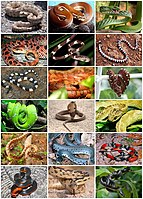
Photo from wikipedia
Abstract. Constraint is a universal feature of morphological evolution. The vertebral column of synapsids (mammals and their close relatives) is a classic example of this phenotypic restriction, with greatly reduced… Click to show full abstract
Abstract. Constraint is a universal feature of morphological evolution. The vertebral column of synapsids (mammals and their close relatives) is a classic example of this phenotypic restriction, with greatly reduced variation in the number of vertebrae compared with the sauropsid lineage. Synapsids generally possess only three sacral vertebrae, which articulate with the ilium and play a key role in locomotion. Dicynodont anomodonts are the exception to this rule, possessing seven or more sacral vertebrae while reaching a range of body sizes rivaled among synapsids only by therian mammals. Here we explore the evolution of this unusual sacral morphology in dicynodonts by (1) hypothesizing homologies of the additional sacral vertebrae, (2) using ancestral state reconstruction and phylogenetic regressions (e.g., logistic regression, Poisson regression) to track the coevolution of sacral count and body size, and (3) proposing mechanisms by which additional sacral vertebrae were incorporated during dicynodont evolution. We find that sacral vertebral morphology covaries with sacral count in consistent ways across dicynodonts, implying that sacra with a given number of vertebrae are composed of homologous elements. There is a correlation between increased sacral count and larger body size, especially at the shift from four to five sacrals near the origin of Bidentalia. Based on position, morphology, and the consistent number of presacral vertebrae among dicynodonts, we hypothesize that the additional sacrals anterior to the plesiomorphic three are duplications of the first sacral, and that a single caudosacral was incorporated by a shift in the identity of the anteriormost caudal vertebra. Although changes in sacral count appear to be correlated with shifts in body size in dicynodonts, the evolution of general morphological conservativism in the synapsid sacrum remains to be further explored.
Journal Title: Paleobiology
Year Published: 2019
Link to full text (if available)
Share on Social Media: Sign Up to like & get
recommendations!